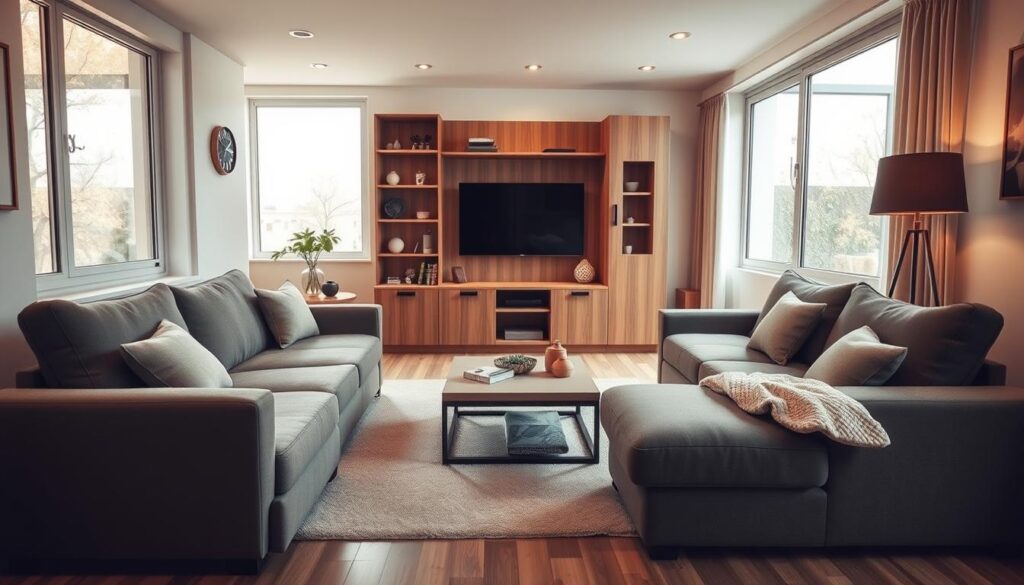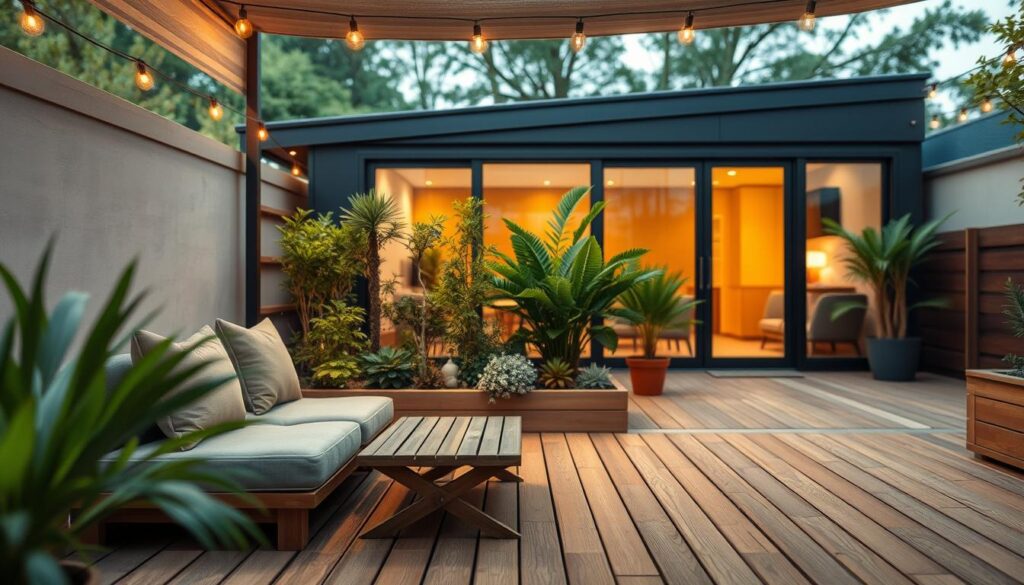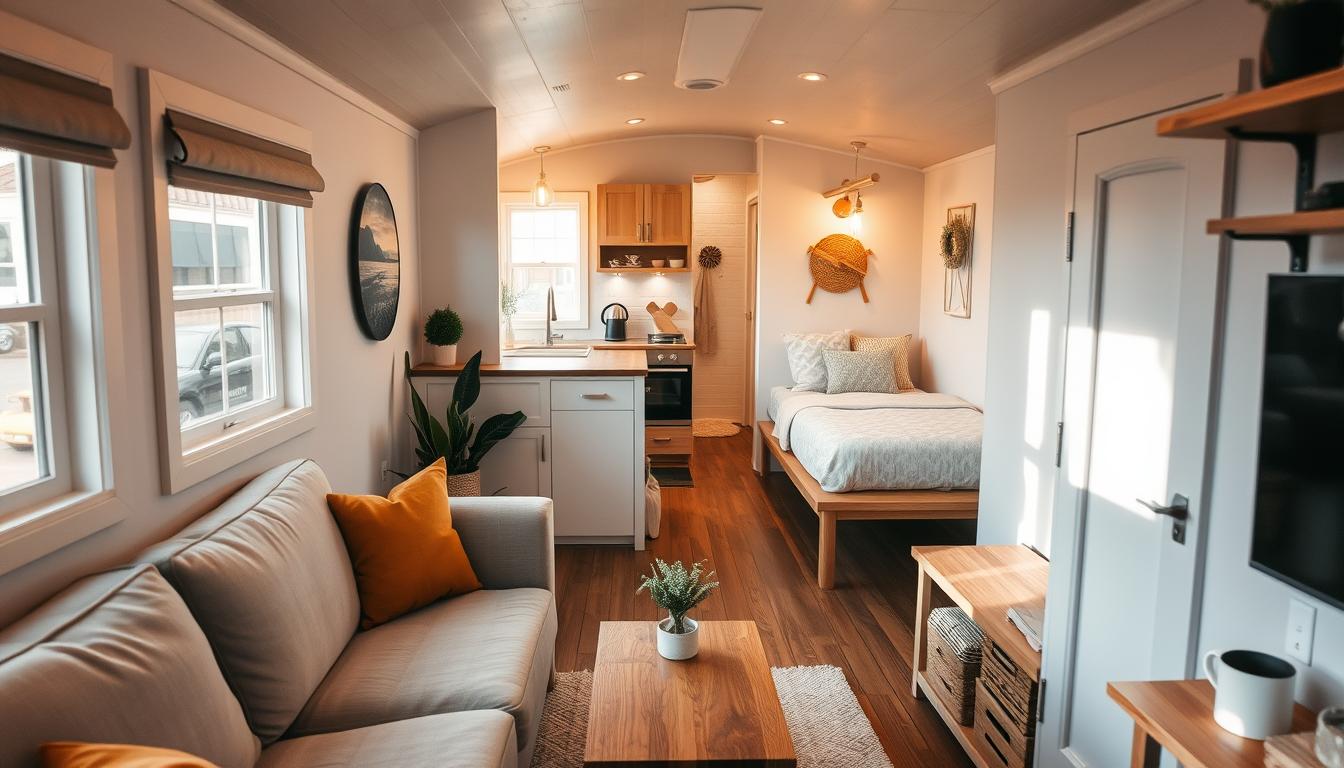Did you know over 10,000 people in the U.S. live in tiny homes? They choose a simpler, more sustainable life. Creating a cozy interior is key to enjoying these small spaces.
To make a small space feel warm and inviting, you need to plan carefully. We’ll look at how to maximize space and pick the right decor. For ideas, check out our cozy tiny home designs.
Key Takeaways
- Maximizing space is crucial in tiny home interiors.
- Choosing the right decor can make a small space feel larger.
- Cozy lighting can greatly enhance the ambiance of a tiny home.
- Multifunctional furniture is a must in compact living spaces.
- Minimalism is key to maintaining a clutter-free tiny home.
Understanding the Appeal of Tiny Homes
Tiny homes are more than just small spaces. They offer a mix of function, green living, and beauty.
What Makes Tiny Homes Attractive?
Tiny homes stand out because of their space-saving design. They let you live with fewer things. This leads to a cleaner, more organized life.
The Benefits of Downsizing
Choosing a tiny home can save you money and help the planet. Here are some key benefits:
- Lower utility bills
- Less maintenance
- A simpler, more organized living space
Sustainable Living in Small Spaces
Living in a tiny home is good for the environment. They use eco-friendly materials and cut down on waste. Tiny home living helps reduce our impact on the planet.
Key Considerations for Tiny Home Interiors
Creating a cozy tiny home interior is all about using space wisely and keeping it looking good. Tiny house organization and minimalist home decor are key to this. They help us make the most of our small space.
We need to think about what’s important to us in our tiny home. What can’t we live without? Knowing this helps us plan where to put things.
Maximizing Space: Functionality vs. Design
Getting the most out of our tiny home’s space is a challenge. We have to balance what works well with what looks good. For example, a piece of furniture that does double duty can save space and add style.
- Choose furniture that also serves as storage to keep things tidy.
- Use the walls for shelves or storage to make the most of vertical space.
- Stick to light, neutral colors to make the space feel bigger.
By using these tips, we can make our tiny home both efficient and beautiful. It’s about finding the right mix of form and function.
Choosing the Right Layout for Our Needs
The layout of our tiny home is crucial for its function and comfort. We should think about how we’ll use each area and how they’ll flow together. A well-thought-out layout can greatly improve our daily life.
- Think about your lifestyle and habits to pick the best layout.
- Consider an open-plan design to make the space feel bigger.
- Use dividers or screens to separate areas in an open space.
Choosing a layout that fits our needs can make our tiny home more livable. It helps us enjoy our space more.
Color Schemes That Enhance Tiny Spaces
The color scheme is key in tiny home interiors. It affects the mood and how big the space feels. Choosing the right colors can make our tiny home feel bigger and more welcoming.
Light vs. Dark Colors: Which Works Best?
Choosing between light and dark colors is a big decision for our tiny home. Light colors make spaces look bigger and feel more open. Dark colors, on the other hand, can make a space cozy but feel smaller.
But we don’t have to pick just one. Mixing light and dark can be a good idea. For example, light colors on walls and ceilings can make a space feel taller and more open. Dark colors can be used for furniture or accents to add coziness and depth.
Benefits of Light Colors:
- Makes the space feel larger
- Creates a sense of openness
- Reflects light, reducing the need for artificial lighting
Benefits of Dark Colors:
- Creates a cozy atmosphere
- Can be used to create contrast and visual interest
- Adds depth to the space
Incorporating Accents for Visual Interest
Accents are important for adding interest to our tiny home interiors. Using different colors, textures, and patterns can make our space dynamic and engaging. We can use accents in furniture, rugs, artwork, or decorative items.
“The key to a great interior design is not just about the color scheme, but how you use it to create a cohesive and inviting space.”
It’s important to find a balance when using accents. Too many can make the space feel cluttered. Too few can make it dull. Finding the right mix is key.
| Accent Type | Examples | Effect |
|---|---|---|
| Colorful Furniture | Rug, Sofa, Armchair | Adds a pop of color and creates a focal point |
| Textured Elements | Woven Basket, Throw Blanket | Adds depth and tactile interest |
| Patterned Decor | Artwork, Pillow Covers | Creates visual interest and adds personality |
By carefully choosing our color scheme and adding accents, we can make our tiny home feel spacious, welcoming, and truly our own.
Furniture Selection: Style and Space Efficiency
Choosing the right furniture is key to a cozy and functional tiny home. We aim for a balance between style and space-saving design. This way, our living area is both comfy and practical.
Multi-Functional Furniture: Must-Haves for Tiny Homes
In tiny homes, multi-functional furniture is essential. Items like sofa beds, storage ottomans, and desks with shelves cut down on clutter. They make the space more useful.
A storage ottoman is perfect for tiny homes. It can be a coffee table, extra seat, and storage for things like linens or toys.

Choosing the Right Size and Scale
Furniture that fits the room’s size is vital. Big furniture can make a tiny home feel tight. On the other hand, small pieces might not offer enough use.
Measuring our space well helps us pick the right furniture. We want pieces that fit well, leaving room to move around.
| Furniture Piece | Standard Size | Compact Alternative |
|---|---|---|
| Sofa | 90 inches | 72 inches or less |
| Dining Table | 42 inches wide | 36 inches wide or drop-leaf |
| Coffee Table | 42 inches wide | Nesting tables or 30 inches wide |
Choosing compact or multi-functional furniture helps make our living space feel bigger and more efficient.
Storage Solutions for Tiny Home Interiors
Tiny homes need smart storage ideas to make the most of their space. Every inch is important, and good storage keeps things tidy.
Creative Storage Ideas for Every Room
There are many creative ways to store things in each room. In the kitchen, using multi-functional furniture like an island with storage is smart. A kitchen cart with drawers is also a great idea.
In the living room, ottomans with storage can be both a seat and a storage spot. They’re perfect for holding throw blankets, books, or board games.
In the bedroom, using the space under the bed is a clever move. Bed risers or storage bins can fit under beds. They’re great for storing out-of-season clothes, linens, or personal items.
Utilizing Vertical Space Effectively
Using vertical space is a top way to add storage in tiny homes. Installing shelves, storage units, or hanging organizers up high is a smart move. It boosts storage without taking up floor space.
In a tiny home bathroom, a wall-mounted cabinet or shelves above the toilet is handy. It keeps toiletries, towels, and essentials within reach. In the living area, a wall-mounted desk or foldable table offers a workspace without using up floor space.
- Use wall-mounted storage units to keep floors clear.
- Install shelves or ledges for displaying decorative items or storing books.
- Consider hanging organizers for closets or entryways.
By using these storage ideas, we can make our tiny home more organized, functional, and cozy.
Lighting Techniques to Elevate Ambiance
In tiny homes, lighting does more than just light up the space. It creates a warm and inviting atmosphere. The right lighting techniques can make our small spaces more comfortable and beautiful.
Natural Lighting: How to Optimize Window Space
Natural light is key to making tiny homes feel bigger and more welcoming. We should think carefully about where and how big our windows are. Maximizing window space lets in more natural light and connects us to the outdoors, which is good for us.
To get the most from natural light, use light-colored window treatments. They let sunlight in while keeping things private. Also, placing mirrors opposite windows can bounce light deeper into the room, making it brighter and more open.
Types of Artificial Lighting for Cozy Interiors
Artificial lighting is also vital, for when it’s dark or in areas with little natural light. There are many artificial lighting options that can make tiny homes cozy. Ambient lighting, like ceiling lights or recessed lighting, lights up the whole space and sets the mood.
Task lighting, such as under-cabinet lights or desk lamps, is great for specific tasks. It adds depth to our lighting design. Accent lighting, like picture lights or floor lamps, highlights special features or creates a focus in the room.
By mixing these lighting types, we get a layered lighting effect. This improves both the feel and function of our tiny home. For a minimalist look, choose sleek and simple lighting fixtures. They help keep the space clean and uncluttered.
Personalizing Our Tiny Home Decor
Living in a tiny home means adding personal touches to make it feel like home. It’s these personal touches that turn a small space into a cozy home.
Incorporating Personal Touches and Memories
Surrounding ourselves with sentimental items is a joy of tiny home living. Family heirlooms, travel souvenirs, and personal artwork add warmth and character. Choose items that hold emotional value and tell a story.
To display personal items, we can use different methods. Floating shelves are great for small items, while a gallery wall showcases photos and artwork. These methods add interest and make our space feel more personal.
| Display Method | Ideal Items | Benefits |
|---|---|---|
| Floating Shelves | Small decorative items, books | Space-saving, versatile |
| Gallery Wall | Photos, artwork, prints | Visual interest, personalization |
| Display Cabinets | Collectibles, heirlooms | Protected display, organized |
Choosing Artwork that Fits Small Spaces
Artwork can greatly enhance our tiny home’s ambiance. Choose pieces that fit the room’s scale. Large, bold pieces can overwhelm a small space, while smaller ones create harmony.
To add interest without clutter, mix frame styles and sizes. A unified color palette ties together different pieces. Using prints or posters is also a budget-friendly way to update our decor.
By carefully choosing personal touches and artwork, we can make our tiny home beautiful and meaningful. This approach not only beautifies our home but also reflects our personality and experiences.
Outdoor Connections: Expanding Our Living Space
Making our indoor and outdoor spaces blend smoothly is key. This way, we can enjoy more of our tiny home. By extending our living area, we improve our life quality.

Designing Functional Outdoor Areas
For tiny homes, outdoor areas are essential. They can be dining spots, places to relax, or even for gardening. We must think about how we use our outdoor space.
Using multi-functional furniture is a smart move. For example, a storage ottoman can be a seat and a place to store outdoor items and gardening tools.
| Outdoor Furniture | Functionality | Space-Saving Tips |
|---|---|---|
| Storage Ottoman | Seat and Storage | Choose a compact design |
| Foldable Dining Table | Dining and Workspace | Fold and store when not in use |
| Vertical Garden | Gardening and Decoration | Utilize wall space |
The Role of Landscaping in Tiny Home Aesthetics
Landscaping is vital for our tiny home’s look. Choosing the right plants and designing our outdoor space makes our home look better. It also connects our home with nature.
For more tips on small home interiors, check out Moderno Interior.
When picking plants, go for native species that need little care. Adding pathways and outdoor lights also makes our outdoor space more beautiful and useful.
By using these ideas, we can link our indoor and outdoor spaces smoothly. This way, we expand our living area and make our life better.
Embracing Minimalism in Tiny Living
Living in a tiny home means we must embrace minimalism. It helps us make the most of our small space. We can live more simply and efficiently.
A Simpler Way of Living
The idea of less is more helps us see what’s truly important. In tiny homes, this means choosing carefully what we keep. We aim for a space that works well and looks good.
By using minimalist decor, our homes become calm and welcoming. It’s a way to make our tiny space feel big and open.
Maintaining a Clutter-Free Environment
To keep our tiny homes tidy, we need to watch what we buy. We use furniture that does more than one thing. We also find ways to store things well.
Decluttering often helps us keep our homes organized. This way, our tiny home feels peaceful and shows off our style.



